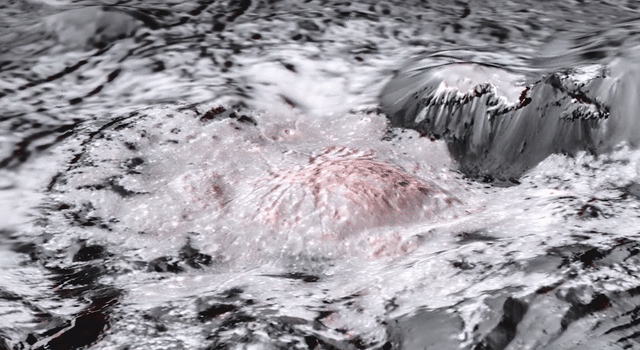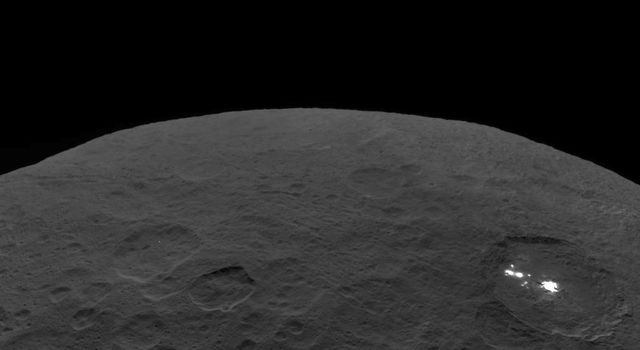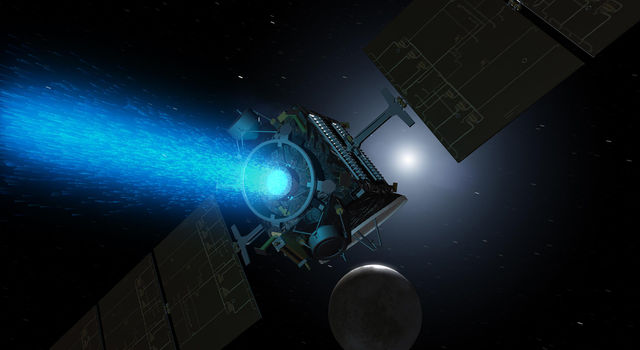Blogs | | January 12, 2014
Another Top Five: Dawn 2013
From Our Chief Engineer
I was delighted to be asked to name my top five accomplishments for the Dawn mission in 2013. This is a very ambitious and exciting interplanetary adventure, exploring some of the last uncharted worlds in the inner solar system. Thanks to its advanced ion propulsion system, this is the only spacecraft ever targeted to orbit two extraterrestrial destinations, and it leaves behind a blue-green wisp of xenon ions as it blazes a unique trail in humankind’s efforts to know the cosmos.
2013 was an extremely successful year, and it is not easy to select only five accomplishments (especially for someone as enthusiastic and wordy as I am), but it also was gratifying to review the year. The specific activities in 2013 may not be as obviously spectacular as in some other years, in which the spacecraft left its home planet behind, swooped past Mars on its way to more distant places, maneuvered into orbit around a giant protoplanet, spiraled down to a daringly low altitude for astonishing views, or climbed away from a world it unveiled, breaking free of its gravity to journey elsewhere in the solar system. But the many accomplishments of 2013 are valuable and impressive, and it will be interesting to see what different members of the team choose for their top five. Here are mine:

1) Delivery of large volumes of richly detailed observations of Vesta with the science camera, the gamma-ray and neutron spectrometer, and the visible and infrared mapping spectrometer to the repository used by the scientific community (the Planetary Data System, or PDS). We went to Vesta to collect these data, and now they are available for use by scientists (and the public) around the world for generations to come, ensuring there will continue to be many wonderful discoveries about this fascinating, complex protoplanet. (The gravity measurements will be available at the PDS in 2014.) For a summary of some of Dawn’s findings at Vesta, which is more closely related to Earth and the other terrestrial planets than to typical asteroids, see the January 2013 Dawn Journal.
2) Outstanding progress in flying Dawn deep in the main asteroid belt between Mars and Jupiter, staying on course and on schedule for our 2015 appointment with dwarf planet Ceres. We are performing a complicated cosmic choreography in order to rendezvous with a distant, moving partner. Dawn accomplished 100 percent of the planned ion thrusting for the year, a total of more than 324 days, or 89 percent of the time. At the beginning of the year, Dawn was 38 million miles (57 million kilometers) from Ceres (and 1.7 million miles, or 2.7 million kilometers, from Vesta). At the end of the year, it had cut that to half, so it was 19 million miles (31 million kilometers) from Ceres (and 20 million miles, or 32 million kilometers, from Vesta). No other spacecraft has ever undertaken such a mission, having left orbit around one distant solar system body in order to orbit another. Dawn is truly an interplanetary spaceship. To read more about Dawn’s route and how it uses its ion propulsion system to accomplish it, visit the February 2013 and April 2013 Dawn Journals.

3) The successful implementation of powerful and creative new methods for conserving precious hydrazine propellant. Because Dawn has lost two of its four reaction wheels, completing the exploration of Ceres in 2015 and 2016 (see #4 below) would be impossible without these changes in 2013. Thanks to the effectiveness of these innovations, there will be enough hydrazine to operate Dawn at Ceres regardless of the health of the wheels. One aspect of this is described in more detail in the November 2013 Dawn Journal.
4) Completion of a new plan for the exploration of Ceres. We have devised a plan that should achieve all objectives of exploring Ceres even if the two remaining reaction wheels fail. Most missions do not have such resilience. The plan is now being translated into the detailed, second-by-second commands that eventually will be loaded into the spacecraft’s computer. The first element of that plan is described in the December 2013 Dawn Journal; the rest will be presented in subsequent installments.
5) Travels far, far from home in an alien environment. During 2013, Dawn voyaged as far as 322 million miles (519 million kilometers) from Earth. This was well in excess of one million times farther from Earth than the International Space Station and Tiangong-1 and more than 1,300 times farther than the moon. Such distances are staggering, and it is astonishing that humankind, thanks to its celestial ambassadors, is able to extend its reach so far beyond its humble home. Visit the August 2013 Dawn Journal to gain further perspective on this deep-space expedition.
With those accomplishments behind us in 2013, we look forward to another productive year as we continue to close in on an exotic new world. I am confident that many thrills, triumphs (and even some disappointments), and rewards lie ahead. I hope you will fly along with us and share in all of it!
TAGS:DAWN







